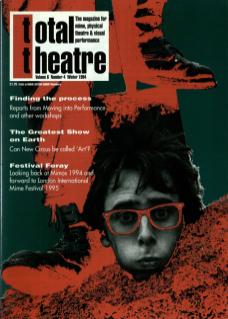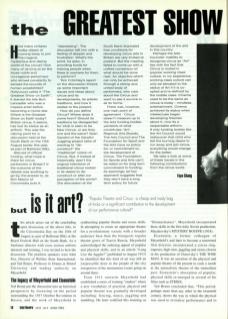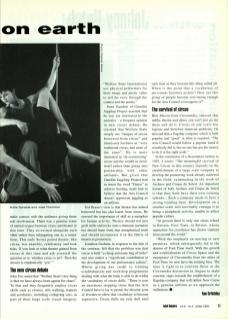This article arises out of the concluding open discussion, of the above title, to the Circomedia Day on 10 August as part of Ballroom Blitz at the Royal Festival Hall on the South Bank. As a freelance director with cross-section artform interests and training, I was invited to host the discussion. The platform speakers were John Fox, Director of Welfare State International, and Ted Braun, Professor in Drama at Bristol University and leading authority on Meyerhold, the legacy of Meyerhold and Eisenstein. Ted Braun put the discussion into an historical perspective by focusing on the period surrounding the 1917 October Revolution in Russia, and the work of Meyerhold in synthesising popular theatre and circus skills. In attempting to create an appropriate theatre for a revolutionary society with a broader audience base than the bourgeois regular theatregoers of Tsarist Russia, Meyerhold acknowledged the enduring appeal of popular and physical skills, and in an article ‘Long Live the Juggler!’ (published in August 1917) he identified that this kind of art was still an irrepressible draw to the people of the city irrespective of the momentous events going on around them.
From 1912 onwards Meyerhold had established a series of training ‘studios’ where a new vocabulary of practical, physical and popular theatre was gradually developed including: fencing, dance, juggling and tumbling. He later codified this training as ‘Biomechanics’. Meyerhold incorporated these skills in the first truly Soviet production, Mayakovsky's Mystery Bouffe (1918).
Eisenstein, a former colleague of Meyerhold's and later to become a renowned film director, incorporated a circus ring, trapezes, high wire, juggling, and circus clowns in his production of Ostrovsky's The Wise Man. It was an assertion of the physical and popular theatre of the present to cock a snook at the naturalistic theatre of the immediate past. Eisenstein's absorption of popular, physical skills re-emerged in several of his films such as Strike.
Ted Braun concluded that, ‘This period, perhaps more than any other in the twentieth century, shows the way in which the physical was used to revitalise performance and to make contact with the audience giving them real involvement. There was a genuine sense of mutual respect between circus and theatre at that time. They coexisted alongside each other rather than subjugating one as a minor form. This early Soviet period theatre, like circus, was anarchic, celebratory and took risks. If you look at what theatre gained from circus at this time and ask yourself the question as to whether circus is art, then the answer is emphatically “yes”!’
The new circus debate
John Fox stated that ‘Welfare State's key thing is that we have always been agents for chaos’. To that end they frequently employ circus skills such as clowns, stilt walking, trapeze and acrobatics, including collapsing cars, as part of their large-scale visual imagery.
‘Welfare State International use physical performers for their image and poetic value to tell the story through the context and the poetry.’
Sean Gandini of Gandini Juggling Project asserted that he was not interested in the narrative – a frequent opinion in new circus debate. He claimed that Welfare State simply use ‘images of circus borrowed from circus’ and dismissed Archaos as ‘very traditional circus, and more of the same’. He is more interested in ‘de-constructing’ circus and the wealth in circus itself rather than going into partnership with other artforms. But given that Gandini Juggling Project had to insert the word ‘Dance’ to achieve funding, leads him to believe that the Arts Council doesn't appreciate juggling as an artform. Ted Braun's view is that theatre has indeed borrowed but has also learnt from circus. He stressed the importance of skill as a metaphor for human activity. Theatre should not just graft skills and tricks onto a dramatic narration but should learn from that metaphorical truth and should incorporate it in the fabric of theatrical production.
Jonathan Graham, in response to the title of the seminar, felt that the problem was that circus is both ‘a cheap and nasty bag of tricks’ and also makes a ‘significant contribution to the development of our performance culture’. Whilst giving due credit to training establishments and workshop programmes dealing with what the body is able to do within the vocabulary of circus skills, ‘There is now an enormous stepping stone that the Arts Council have to lay to permit the director, poet or inventor to allow that vocabulary to become expressive. Circus skills are only skill until such time as they become this thing called art. When is the point that a vocabulary of movement becomes artistic? How can this group of people become convincing enough for the Arts Council to recognise it?’
The survival of circus
Bim Mason from Circomedia stressed that unlike theatre and dance you can't just go out there and do it. Circus of any scale has logistic and therefore financial problems. He stressed that a flagship company which is both popular and ‘good’ is what is required: ‘The Arts Council would follow a popular trend if somebody did it, but no-one has got the money to do it at the right scale.’
In the conclusion of a dissertation written in 1991, I wrote: ‘The meaningful survival of New Circus in this country depends on the establishment of a large-scale company to develop the pioneering work already achieved in the field, culminating in the work of Archaos and Cirque du Soleil. An important feature of both Archaos and Cirque du Soleil is that they both have their own training schools... Such a company needs to have a strong training base. Development on a smaller scale will inevitably consign it to being a peripheral activity, unable to affect popular culture.’
‘At present there is only one circus school in Britain, Fool Time, in Bristol, whose reputation for excellence has drawn students from around the world.’
With the emphasis on moving to new premises, which subsequently led to the demise of Fool Time itself. With the growth and establishment of Circus Space and the emergence of Circomedia from the ashes of Fool Time, we now have the training base. The time is right to re-convene those at the Circomedia discussion in August to make concrete steps towards the establishment of a flagship company that will define New Circus as a genuine artform as we approach the Millenium.


